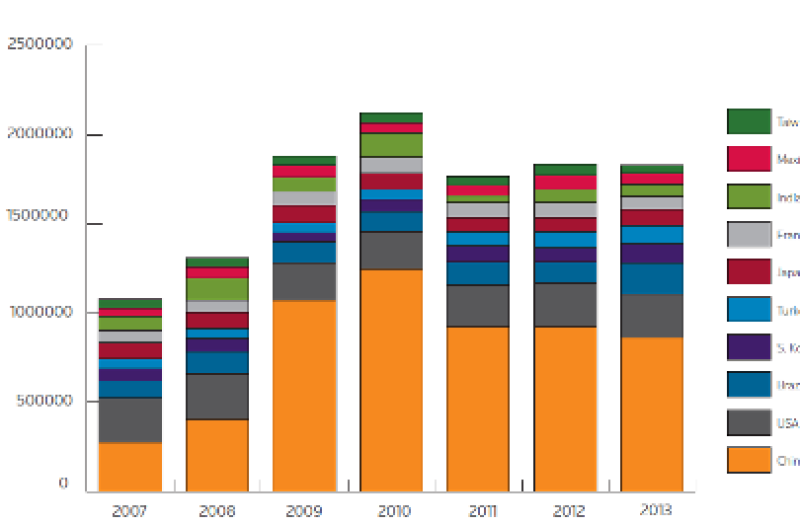That’s one conclusion to draw from the latest trade mark publication data reported by Thomson Reuters Compumark last week (download the full report here – you’ll need to fill in your details). The figures are derived from the company’s SAEGIS on SERION tool, and cover published trade marks for 186 countries and across all classes.

The headline, which may not be surprising, is that emerging markets are replacing established countries in the top 10 (publications ranked by total volume). In come India, Mexico and Taiwan. Out go Canada, Germany and the UK. As the authors say, this reflects the focus of many brand owners, particularly in the FMCG sector: “The world’s leading retail brands – the United Kingdom’s Tesco, Metro in Germany, Wal-Mart in the United States and France’s Carrefour – all saw their revenues grow 2.5 times faster in developing nations than they did in their home markets during 2013.”
But behind that trend there is surprising variance. Russia is not growing as you might expect. China ranks number 1 for publications (with 860,000), but the number fell 15% in 2013. India has been up and down, but peaked in 2010.
Readers will note that (unlike filing trends) trade mark publication figures can be affected as much by government action (for example investing in examiners to cut backlogs) as applicant activity. The report also excludes regional systems, such as the Community trade mark.
So where is going to be big next? I spoke to Kristin Geboers (below right), senior marketing manager at Thomson Reuters, and with her help identified five jurisdictions to watch over the next few years. (The BUSTT acronym, I should add, is ours not that of Thomson Reuters.)

Brazil: The South American country ranks number three on the list, and saw the largest year-on year increase in publications of 53%. In the short term, the football World Cup and 2016 Olympics will surely keep it growing, while longer-term Kristin points to its strength in the fashion industry (it leads the world in denim production, apparently) and appeal to consumer goods companies, as well as recent pharmaceutical reforms that will encourage filings in class 5.
United States: While other western countries have slipped out of the top 10, the United States maintains its position as number 2 behind China. Publications have been flat for the past few years, but Kristin predicts that the expected economic recovery will lead to further growth.
South Korea: As in the US, class 9 is big in Korea, thanks to its high-tech industry (contrast that with China where classes 25 and 35 are the most significant). The country comes in at fourth in the ranking, and publications grew by 23% last year to nearly 130,000 published trade marks across all classes.

Turkey: Perhaps surprisingly, Turkey ranks fifth in the top 10, with publications increasing by 18% in 2013. They were led by class 35 following a reform implemented in 2011 to bring the country into line with the CJEU decision in Praktiker, which led to thousands of new applications. That may be a quirk, but longer term the country’s growing, young population and increasing ties with both markets in both Europe and Asia should lead to further growth, provided there is political stability.
Taiwan: This is our wild card. Despite having a population of just 23 million, Taiwan manages 10th place in the Thomson Reuters list, with more than 66,000 publications (across all classes) in 2013 – more than Australia, Italy, Russia or Switzerland. It is well placed to benefit from wider Asian growth, particularly in technology industries, so it could rise even higher.
So there you have it. I’d be interested to know what practitioners on the ground think: are you seeing growth? Do you think it is sustainable? What changes could improve things? Is it possible to have boom and BUSTT? Please send us your comments.










